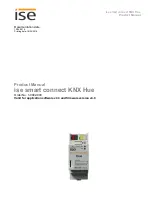
ise smart connect KNX Hue
Product description
Order No. 1-0002-003
Product Manual Page 6 (60)
1.3
Definitions and explanation of terms
Hue Bridge
Philips base station to connect LED lights to the WLAN router: the Hue Bridge and Hue lights are
connected wirelessly using Zigbee. The ise smart connect KNX Hue uses the Philips Hue Bridge to
control the Hue lights using IP. Up to five Hue Bridges can be controlled with a ise smart connect
KNX Hue.
Hue light
All the LED light sources in the Hue series, including the LightStripes and the Friends of hue. The
Hue Lux can be used with the application software version 3.1 or higher. No systems which contain
a Hue Lux can be operated with earlier versions.
Hue Lux
Hue Lux lights produce a pure white light. The brightness control and the alarm effect are useful for
such lights, but the colour control is not.
The ise smart connect KNX Hue also supports the controller for Hue Lux lights with communication
objects to control colours with the application software version 3.1 or higher.
Since white is produced as an additive mix between red, green and blue at the same intensity, the
ise smart connect KNX Hue interprets each change in the colour control as a change in brightness.
The respective highest RGB code is taken as the basis for interpretation. You will find instructions
in the description of the communication object concerned (see Chapter 5.4.4 Communication ob-
jects to control the Hue lights).
RGB colours
The RGB colour model describes individual colours as a mixture of a quantity of red, green and
blue light based on the three-colour theory. Any required colour can be created by mixing the three
primary colours. A numerical value is used to define the red portion R, green portion G and blue
portion B of the colour.
Light scene
A light scene combines light colour and brightness for one or more Hue lights, saved for repeated
use. As you will see below, each state of a Hue light (including simply "off") is designated as a light
scene.
Alarm effect
The alarm effect is a time-limited state change in a light. The standard example is uniform change
in brightness. From the original state to brighter to darker and then back to the original state. The
colour of the light does not change here.
Dynamic effect
A dynamic effect consists of the light running through a state change until the user stops the
changes.
An example of this would be the colour change sequence. Here, the entire RGB colour space is run
through in an endless loop.





















